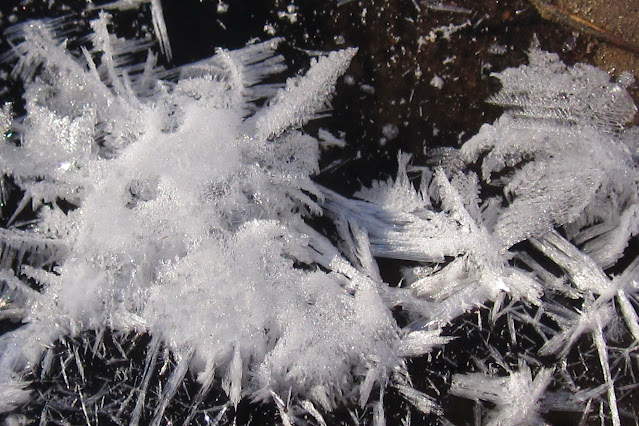It looks like we're going to have a real winter this year - in New Hampshire as well as the rest of the East Coast. Saturday morning brought us the coldest temperatures we've had in three years: -9.8 degrees on our thermometer. But at least it's been calm, and as the cold strips the moisture out of the air it brings along some brilliant blue-sky days.
 |
| Looking north over Winnipesaukee from Weirs Beach on Friday. |
From reports I've heard, all of the lakes are frozen over now but that doesn't mean they're all safe yet. Certainly Wicwas has been safe for quite a while and I've seen ATVs and snowmobiles on Winnisquam and Paugus Bay.
 |
| Bob houses and plenty of snowmobiles on Lake Wicwas. |
The good news is the winter events are all good to go: Pond Hockey, the fishing derby, the Meredith Conservation Commission outing at Page Pond; even the Alton Bay ice runway should be opening soon - it currently has ten inches of ice and they are planning to plow it on January 26th based on the forecast for continued cold weather. Hopefully the Sled Dog races scheduled for February 11-13th will also be able to run.
One conspicuous sign of cold air is a jet's condensation trail, or contrail.
 |
| I think that's an Emirates Airline flight heading east over New Hampshire on it's way to Europe. |
Contrails are made by water vapor which is a by-product of the engine's combustion freezing in the cold air; they're clear and sharp when it's this cold but they don't linger when the air is so dry because they're quickly absorbed into the atmosphere.
Even on cold days the bright sun, already noticeably higher in the sky, sets the stage for outdoor activities on the lakes and mountains, though tracking opportunities haven't been very good due a thin crust on top of the snow. That means no tracks are left by anything lighter than say a deer, and those larger animals stay close to their deer yards as they don't like punching their hooves down through the sharp crust - it can cut their legs and also makes it nearly impossible for them to outrun a predator. But even when there are no tracks to be seen there's usually something interesting to be found out in the winter world. On one snowshoe trip I came across a charming little bird nest lying right in the middle of the unbroken trail.
 |
| A forgotten birds nest blown to the center of the trail. |
I believe it's a goldfinch nest - it's the right size and shape, and assembled with pine needles and soft plant fibers. The architect's meticulous construction kept the nest intact through time and weather, even after finally being ripped from its fork in a tree by the wind after the last storm.
 |
| This sturdy nest is about three inches across. |
A goldfinch nest is built entirely by the female and it takes her about six days to complete it. [Ref: Cornell Lab of Ornithology] She usually builds it in the fork of a small tree near the edge of an open area that has flowers and weeds and other field-based plants with the small seeds that goldfinches prefer.
During its use the inside would have been lined with soft down for the eggs and newly hatched chicks. Goldfinches don't reuse a nest the following year so it's not a concern for the owner that it blew away. I thought about popping it into my pack to bring home for our nature collection but elected to leave it in the trail for the next hiker to enjoy.
I mentioned deer earlier, and someone (thanks JP!) sent me a nighttime photo of a nice buck visiting their yard.
 |
| A white tail deer avoids the crusty snow. Photo by Jackie Powell. |
It shows how deer will take advantage of plowed roadways for safe (from predators, not vehicles) and energy efficient travel routes. That nice set of antlers will be falling off soon. I've never found an antler on the ground - the small critters of the woods gobble them up quickly to take advantage of their high nutrient content including calcium which is scarce in New England forests.
I'll end with another cold weather phenomenon, this one seen in a shallow pool in a small, slow moving stream.
 |
| Ice crystals form atop gently flowing water. |
Whether it's snowshoeing, skiing, ice fishing, or simple beauty, cold air and water combine in many ways for our winter enjoyment.


No comments:
Post a Comment